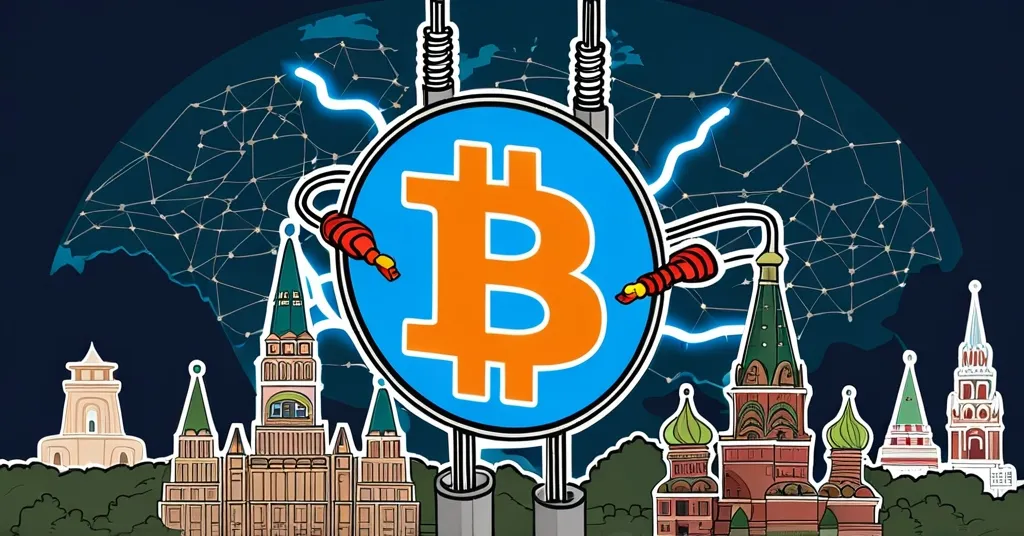Russia’s Bitcoin Mining Surges 7% in 2024 Despite Energy and Regulatory Hurdles

Russia’s Bitcoin Mining Sector Grows 7% in 2024 Amid Regulatory Challenges and Energy Issues
Russia’s Bitcoin miners are not just mining for gold; they’re consuming enough power to light up a small country. In 2024, the sector has seen a 7% increase in mining farms, totaling 136,600 units, but this expansion comes with its own set of challenges, especially regarding energy consumption and regulatory oversight.
- 7% growth in Russia’s Bitcoin mining sector
- 11 GW total mining capacity, with only 3 GW used by registered operations
- Significant losses to power grid due to unregulated mining
- New regional bans and proposed national registry for mining hardware
- Exploration of dedicated power plants for miners
Growth in Mining Farms
The Russian Bitcoin mining sector has witnessed a robust 7% growth in 2024, reaching 136,600 mining farms. This surge underscores Russia’s position as the world’s second-largest crypto mining hub, behind the U.S. The growth is fueled by the support of major state companies like Gazprom Neft and Sberbank, which have turned to crypto mining to offset losses from Western sanctions. Russia’s cold climate and access to cheap electricity make it an attractive location for miners, particularly in regions like Irkutsk, Sverdlovsk, and Krasnoyarsk.
Energy Consumption Challenges
With a total mining capacity of 11 gigawatts (GW), Russia’s mining industry is a powerhouse. To put it in perspective, a gigawatt is a unit of power equal to one billion watts, similar to the output of a large power plant. However, only 3 GW of this capacity is harnessed by legally registered operations, highlighting a significant gap between potential and current utilization.
The unregulated side of mining has taken a toll on Russia’s power grid, Rosseti, which reported financial losses exceeding 1.3 billion rubles, or about $14.2 million, due to illegal mining activities. The North Caucasus region faced the highest losses, with damages surpassing 600 million rubles, roughly $6.5 million. That’s enough power to run a city the size of Moscow, and it’s leaving the grid feeling more like a sieve than a solid structure.
Government Regulatory Measures
In response to these issues, the Russian government has introduced regional bans on Bitcoin mining in 11 areas starting January 2025, and imposed restrictions during peak energy demand periods in certain locales. This move aims to curb the financial losses and stabilize the power grid. Additionally, Russia’s Energy Ministry has proposed a national registry for mining hardware to bring more operations under legal oversight.
Aisen Nikolaev, head of the State Council Commission on Energy, has also proposed a novel solution:
“Russia may soon take a bold step in regulating its growing crypto mining industry by constructing dedicated power plants exclusively for Bitcoin miners.”
This initiative could not only stabilize electricity supply but also allow regulated mining to flourish under government supervision. Imagine power plants built just for miners—talk about a dedicated energy source!
Global Bitcoin Price and Influences
Amid these domestic developments, Bitcoin’s global price continues to climb, currently trading at $98,716, up 1.54% in the last 24 hours. This rise is influenced by a mix of factors, including improved U.S.-Russia diplomatic relations, a more lenient approach to crypto regulation by the U.S. Securities and Exchange Commission (SEC), and the SEC’s approval of a yield-bearing stablecoin—a type of cryptocurrency designed to maintain a stable value while offering returns to holders. Russia’s mining growth and regulatory changes are part of this broader market narrative.
Counterpoints and Critical Perspectives
While the growth of Russia’s Bitcoin mining sector is a testament to the country’s commitment to the crypto industry, it’s not all sunshine and rainbows. The environmental impact of Bitcoin mining, particularly its energy consumption and carbon emissions, is a growing concern. Critics argue that the sector’s expansion could exacerbate these issues, especially if unregulated mining continues to siphon power from the grid. Discussions on platforms like Reddit highlight the energy consumption debate.
From a Bitcoin maximalist perspective, the increased government oversight raises questions about the future of decentralization. While a national registry and dedicated power plants might bring more miners into compliance, they could also centralize control, potentially undermining the very principles that make Bitcoin revolutionary. It’s a delicate balance between fostering growth and maintaining the integrity of the cryptocurrency ecosystem.
Conclusion
Russia’s commitment to the crypto mining industry is clear, with major state companies backing the sector and innovative solutions like dedicated power plants on the horizon. As the world watches, the question remains: can Russia strike the right balance between growth and regulation in the crypto mining symphony? The future of Bitcoin mining in Russia will depend on navigating these complexities with a keen eye on both economic benefits and the broader implications for the crypto world.
Key Takeaways and Questions
- What was the growth rate of Russia’s Bitcoin mining sector in 2024?
The growth rate was 7%, with the number of mining farms reaching 136,600 units.
- What is the total mining capacity in Russia, and how much is utilized by legally registered operations?
The total capacity is 11 GW, with only 3 GW used by legally registered miners.
- How much financial loss did Rosseti suffer due to illegal Bitcoin mining in 2024?
Rosseti reported losses surpassing 1.3 billion rubles ($14.2 million) in 2024 due to illegal mining.
- What measures has the Russian government taken to address the issues with Bitcoin mining?
The government has introduced regional bans effective January 2025, proposed a national registry for mining hardware, and is exploring the construction of dedicated power plants for miners.
- What is the current price of Bitcoin, and what factors are influencing its rise?
Bitcoin is currently trading at $98,716, up 1.54% in the last 24 hours. Factors influencing its rise include improved U.S.-Russia diplomatic relations, a more lenient approach to crypto regulation by the SEC, and the SEC’s approval of a yield-bearing stablecoin.
- Why is Russia considering the construction of dedicated power plants for Bitcoin miners?
Russia is considering this to stabilize electricity supply, allow regulated mining to continue, improve oversight, and mitigate energy losses caused by unregulated mining activities.



